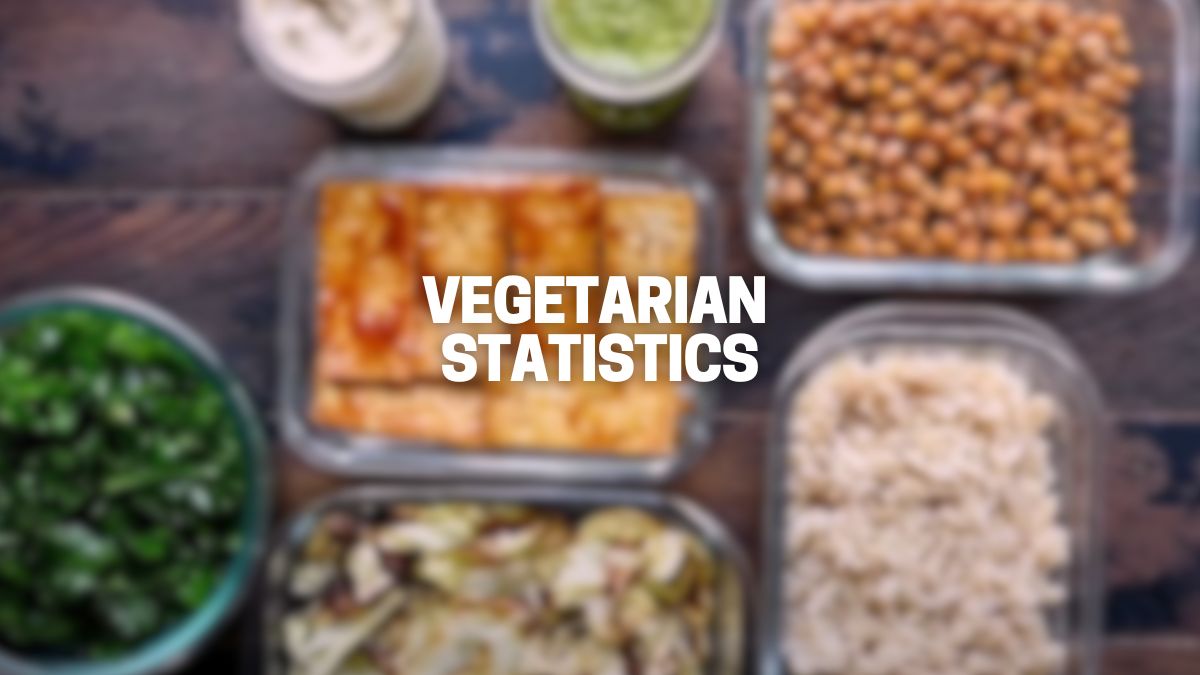It is never the intention of the Great Green Wall to tell people what is morally correct or incorrect. But as more people consider going meatless (as a challenge for any other reason), I’ve been asked to provide some insight.
Below is the painstaking work of several weeks to provide only facts and figures about Vegetarianism. No judgements here at the Great Green Wall, whether you choose to keep with meat, swear off completely, or stay in the middle somewhere.
While there is necessarily some bleed between the Vegetarian and Vegan definitions and populations, we will do our best to differentiate based on that data. If you would like specific data regarding Vegan markets, demographics, and statistics, please check our Vegan article.
In instances where a source has cited “meatless,” “plant-based,” or some other term not strictly delineated to Vegetarian or Vegan, we have opted to use those statistics in this piece, as we cannot verify that those studies defined those terms in strict Vegan terms.
General Statistics
There are startling trends in the more wealthy countries, and one of them is meat consumption. Countries like the US, UAE, and Brazil make up the top 20 meat-consuming countries in the world, all of them consuming more than 160 kg of meat per person, per year. [1]
Below are the macro numbers for people going the other way, the Vegetarians around the world. After the countries break down are some specific numbers on the US and other major countries.
- Global Vegetarian Population Percentages [2]
➔ The Top Ten, in order, are:
- India – 31-42%
- Mexico – 19%
- Brazil – 14%
- Taiwan – 14%
- Switzerland – 13%
- Israel – 10.3%
- New Zealand – 10%
- Germany – 10%
- Sweden – 10%
- Canada – 9.4%
- The US comes in as the 15th largest share of the Global Vegetarian Population at 5-8% of the total.
- Many of these data are on the move (see India, above). Reasons for shifts towards and away from Vegetarianism include social, religious, and economic.
➔ In 2019, one third of Indians in Urban centers were Vegetarian, but by 2022 only one quarter were Vegetarian. [3]
For US statistics, we turn to recent Gallup poll: [4]
- 23% of Americans try to eat less meat every year.
- That number skews heavily toward women (31%) versus men (15%).
➔ It also skews toward People of Color: 31% of nonwhites versus 19% of whites eating less meat. - Another source (Pew Research) has 8% of all Black Americans as strict Vegetarians or Vegans.
- Numbers across demographics are roughly equal:
- 18-29 – 23%
- 30-49 - 19%
- 50-64 - 23%
- 65+ - 26%
- Only 7% of Americans say they “rarely” eat meat.
- Even less, 3%, say they never eat meat at all. (Compare this number to a different Gallup poll, below.)
- 90% of people say that health is one reason for eating less meat.
- 70% cite the Environment as a reason for going meatless.
- Other reasons for not eating meat are:
➔ Food Safety – 65%
➔ Animal Welfare - 65%
➔ Family Members - 40%
➔ “Other” people - 34%
➔ Religious considerations - 30%
- Of Americans eating less meat 69% eliminate it entirely from some meals.
- Only 36% are using plant-based “meats.”
A separate Gallup poll puts the US Vegetarian population at 5%.[5]
- This percentage has actually gone down in the last twenty years.
- Demographics among Vegetarians are highly segregated by income, politics, and age:
➔
7-8% of people 18-49 are Vegetarian. Only 2-3% of older adults are.
➔ 9% of people making less than $30,000/year are Vegetarian; only 4-5% of higher income brackets are.
➔ 11% of “Liberal” people are Vegetarian; only 2-3% of “Moderate” and “Conservative” people are. - Numbers from Women’s Media indicate that 74% of all Vegetarians in the US are women.[6]
- These numbers can be judged against meat consumption.
➔ Americans eat around 200 pounds of meat per year!
Millennials Vs. the World
Many of the factors we’ve discussed that move someone toward vegetarianism have been typified by the apparent ethos of the second youngest generation with an adult population. Millennials (broadly referring to people born between 1981 and 1996) have cited a number of factors for their larger propensity to go meatless.
- Millennials are 30% more likely to choose non-meat options versus older populations.[7]
- A third of all Millennials actively try to avoid meat.[8]
- 22% of Millennials have adopted a Vegetarian diet at any given point; that drops to 13% for Gen X people, and 11% for Baby Boomers.
- Millennial (22%) and Gen Y (23%) adults are willing to forego all meat for environmental reasons; 42% of all adults say they would limit, but not forego, their meat consumption for the environment.[9]
- 37% of Millennials agree with the assessment that meatless is healthier.
- Perhaps due to generational factors, by 2040 some estimate that only 40% of the world will still eat meat.[10]
Health Impacts
As mentioned before, there are some people who decide to go meatless for health reasons. Large statistics are hard to come by in this category, though we can make inferences from clinical studies and reviews of medical literature.
- A review of 96 studies revealed a significant improvement in health among Vegetarians and Vegans.[11]
- One such study found that Vegetarians are 32% less likely to have cardiovascular hospitalizations.[12]
- Another source indicates that Vegetarians have fatal heart disease 25% less often.[13]
Economic Impacts
As more and more people take to a meatless diet, there have been shifts in the global marketplace reflecting the new trends.
- Plant-Based Sales nearly $1.5 Billion. [14]
- In the US, plant-based food sales have risen by 8.1% [15]
- This number takes the total sales over $3 Billion annually.
- Plant-based dairy-replacement beverages look to take 40% of the market.
The Economic and Social Research Institute [16] has compiled a comprehensive, 45 page report on the economics and global impact of meat-based diets viz a viz vegetarian ones. Here are some highlights from their findings. (These data are dated, but remain some of the most comprehensive ever collated.)
- Over 1.5 Billion people worldwide eat no meat whatsoever.
- Of them, however, over 95% of them would eat meat if they could.
- That means that most people around the globe are only vegetarian because of economic reasons.
- Part of the lack of availability is because global meat consumption has risen by over 250% –most of which growth is in wealthy countries.
Environmental Impacts
Another major reason we’ve seen for people choosing some form of Vegetarianism is Environmental concerns. Most of these numbers relate to meat production, which by choosing a Vegetarian lifestyle, many people hope to offset or mitigate.
- Roughly 15% of all greenhouse emissions are from livestock production.[17]
- 80% of all agriculture land use is meat or dairy based.
- Meanwhile, these animal food products only account for 37% of all protein consumed–that’s almost two-thirds of global protein coming from plants. [18]
- Taking all agriculture into account, meat and dairy make up 60% of all pollution, while only making up 18% of all calories.
- One cow can release up to 100 kg (220 lbs.) of methane per year.
➔ There are approximately 1.5 Billion cows in the world, resulting in over 100 Billion kg of methane per year.
- Additionally, in the US alone, livestock for human consumption takes up over 40% of all water consumption. [19] This can be further broken down as:
- 477 gallons of water needed for one pound of chicken eggs, and
- Nearly 900 gallons of water for a pound of cheese. [20]
- Globally, this water use climbs to 70% of all freshwater. [21]
- Worldwide, reducing animal consumption could provide enough water to sustain 1.8 Billion people.[22]
- As human population continues to swell, it is worth noting that livestock currently uses 45% of the Earth’s land.
- This land use often comes at the expense of precious resources. For instance, 80% of Amazon Rainforest loss is because of land for cattle. [23]
- Land and water aren’t the only consideration. After all, the food animals eat must usually be grown. That means nearly 33% of all grains grown are used to feed animals.[24]
Attitudes
The following were taken from a poll [25] and provide qualitative data for people’s choices. These answers are difficult to put into statistical terms, but can help interpret the data that are empirical.
- “Top Priority” for people looking for meat substitutes is taste.
- Millennials view truth in labeling about practices in production as a “must have.”
- 40% of Millennials cook meals based on different cultures, thus influencing attitudes about meat and consumption.
Final Thoughts
Choosing a full lifestyle change can be difficult. In our next article, on Veganism, we’ll discuss one of the most difficult choices of all. But for this piece, I hope I’ve given you, dear reader, some things to digest. If you have any questions, or want some other data, please drop us a line, or add something in the comments, below.
References






